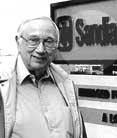|
Research
|
| ||||||||||||||||||
|
DOE's Argonne
National Laboratory is working with IBM and VA Linux Systems to
build "Chiba City"—the largest supercomputing cluster dedicated
to highly scalable open source software development. The 512-CPU Linux
cluster will be opened to the U.S. research community, including universities,
laboratories and industry.
The Chiba City Project, conceived by Argonne's
Mathematics and Computer Science Division, will be Argonne's most powerful
supercomputer. The project will help advance the use of state-of-the-art
Linux clusters based on affordable industry standard components in high-performance
computing. The cluster comprises 256 2-CPU computational servers from
VA Linux Systems, and IBM Netfinity servers for cluster management,
file storage and visualization.
The Chiba City cluster provides a flexible
development environment for scalable open source software in four key
categories: cluster management, high-performance systems software (file
systems, schedulers and libraries), scientific visualization, and distributed
computing.
The construction was planned and managed
by engineers from Argonne and VA Linux Professional Services, with support
from VA and IBM's cluster hardware and software experts. VA Linux also
provided cluster management technology and certified new high-performance
Linux drivers for the gigabit ethernet cards and graphics cards used
in the scalable cluster. The cluster installation was accomplished in
a two-day "barn-raising" event, complete with banjo player. More than
fifty Argonne scientists pitched in to help build the cluster, which
links high-performance servers from VA Linux with advanced hardware
from IBM and the latest in network interconnect hardware.
"The Chiba City barnraising is a great
example of the kind of community spirit that the project will support,"
said Remy Evard, manager of advanced computing and networking in Argonne's
Mathematics and Computer Science Division. "Linux clusters are attractive
for their price and performance, but more importantly, Linux and open
source tools enable our community to work together to tackle large-scale
systems software challenges."
"Argonne's Chiba City is a milestone in
large-scale Linux systems design, and demonstrates the flexibility and
scalability of VA's ClusterCity architecture," said Dr. Larry M. Augustin,
president and CEO of VA Linux Systems. "Chiba City will help advance
open source projects such as VACM, the VA Cluster Manager, and will
benefit the community immensely."
"The prospect of building supercomputer-class
systems using commercially available Netfinity servers is an exciting
one," said Tom Figgatt, Linux segment executive, IBM Netfinity Servers.
"As demonstrated this week at Supercomputing '99 in Portland, IBM is
working with the nation's premiere research institutions including Argonne
to develop the technologies that will make this a reality."
The Chiba City effort is sponsored primarily by DOE's Office of Science. The project gets its name from the futuristic "Chiba City" in William Gibson's science fiction novel, "Neuromancer." For more information, contact Dave Jacque, Argonne Office of Public Affairs, 630/252-5582, info@anl.gov. Submitted by DOE's Argonne National Laboratory |



